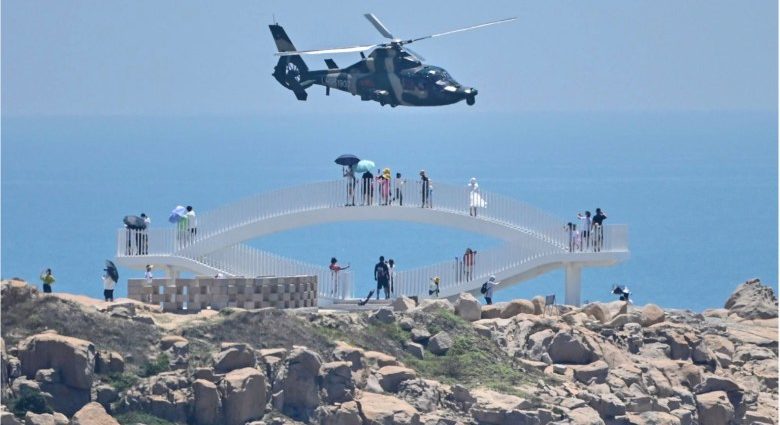China has unveiled a new long-duration surveillance and precision strike drone, known as the KVD002, an aerial weapon that could have significant implications in the event of a conflict over Taiwan.
State media outlet China Daily reported that the People’s Liberation Army (PLA) Ground Force has unveiled its first combat drone that can cooperate with helicopters in combat operations, provide battlefield intelligence and fire support, guide attack helicopters to their targets and make short takeoffs and landings on a plateau.
The KVD002 can carry two AR-1 air-to-surface missiles under its wings and reconnaissance devices beneath its main body, according to the China Daily report published earlier this month. The new drone is based on the CH-4, China’s bestselling unmanned combat aircraft.
China Daily notes that the CH-4 model can stay aloft for 30 hours, has a maximum speed of 230 kilometers per hour and can carry nearly 350 kilograms of weapons and equipment, including missiles, bombs, radars, cameras and civilian payloads. It also notes that the CH-4 has accumulated over 20,000 hours of flight time worldwide.
Global Times, a Chinese Communist Party-run publication, reported this month that the KVD002 has likely participated in patrols and exercises around Taiwan since 2022 but was previously misidentified as the CH-4. The report suggests that the KVD002 is a CH-4 variant specially customized for the PLA Ground Force.

Neither the PLA Ground Force nor the Aerospace CH UAV company has officially commented on the relationship between the KVD002 and the CH-4, according to Global Times.
The mouthpiece publication notes Taiwan’s defense authority occasionally reported the presence of CH-4 armed reconnaissance drones during daily patrols and exercises around the island in September 2022.
The KVD002’s unveiling may indicate China’s growing confidence in its drone operations over the Taiwan Strait and signal more significant trends in China’s military drone development program.
In a 2018 paper for the China Aerospace Studies Institute, Elsa Kania notes that the PLA is integrating military robotics and unmanned systems into its force structure and is actively researching and developing them for all domains of warfare.
Kania says the PLA is deploying various drones across its service branches and introducing more advanced, multi-mission drones. She also mentions that China utilizes its commercial drone industry for smaller, less specialized unmanned systems.
In a May 2022 article for the Institute for Strategic Research, a French Ministry of Armed Forces publication, Loro Horta asserts that the PLA views drones as crucial as any other main combat system such as fighter jets and submarines.
Horta says that, unlike other militaries, the PLA does not see drones as mere auxiliaries but rather as an essential fighting system to compensate for certain of its weaknesses.
He writes that while China has recently fielded cutting-edge weapons such as the J-20 5th generation stealth fighter, nuclear attack submarines (SSN) and aircraft carriers, many observers believe they are still inferior to their US counterparts.
Horta argues China seeks to offset this disadvantage by employing an asymmetric strategy built around repulsing US carrier battlegroups with long-range missiles, aircraft, submarines and drones.
Horta notes in a separate February 2022 Pacific Forum article that in a conflict with the US over Taiwan, the PLA Navy has no intention of engaging in an open conventional naval battle such as the Battle of Midway.
Instead, he says that US forces will have to approach China’s coast where the PLA Navy and PLA Air Force have the advantages of proximity to their logistics bases and missile protection.
Intensified Chinese drone operations around Taiwan may be part of a more extensive aerial attrition strategy to test Taiwan’s defenses and wear down its air force.
Asia Times reported in August 2023 that China has escalated military exercises east of Taiwan, aiming to prepare for a potential blockade to facilitate eventual “reunification” with the mainland.
Chinese ships and aircraft have been increasingly active in the Western Pacific, particularly in the Philippine Sea to the east of Taiwan, since then-US House Speaker Nancy Pelosi visited Taiwan in August 2022.
In December 2022, China deployed its Liaoning aircraft carrier east of Taiwan, followed by the Shandong carrier in April 2023. A Chinese TB001 was spotted flying in an unusual flight path around Taiwan in April, and in May, a BZK005 reconnaissance drone was spotted off the east coast of Taiwan.
Reports also indicate that sightings of Chinese aircraft in the airspace east of Taiwan have significantly increased since March.

China may employ an aerial attrition strategy against Taiwan by pushing it beyond its operational capacity. This strategy can lead to misjudgment and unintended escalation caused by exhausted pilots and ground crew, equipment damage, logistics and maintenance issues, and accidents.
The strategy further pressures Taiwan’s already overstretched, understaffed and aging air force. Asia Times reported in May 2023 that Taiwan’s current fighter force of F-16s, Mirage 2000s, IDFs and F-5s is geared to repel a Chinese invasion in their current state and configuration.
But over half of Taiwan’s jets reportedly are not currently mission-ready and would require at least a week to be moved into shelters, leaving them vulnerable if China attacks while they are still on the ground – a preemptive strike that could potentially be launched by the new KVD002.

